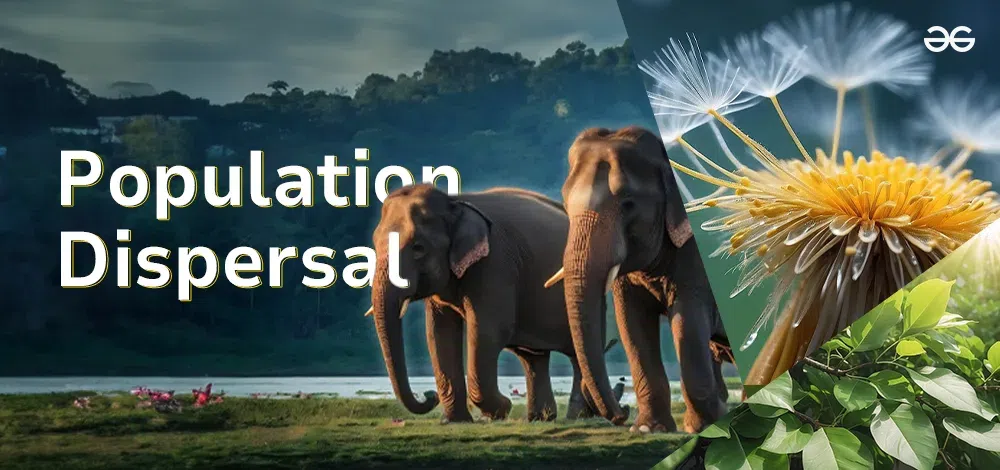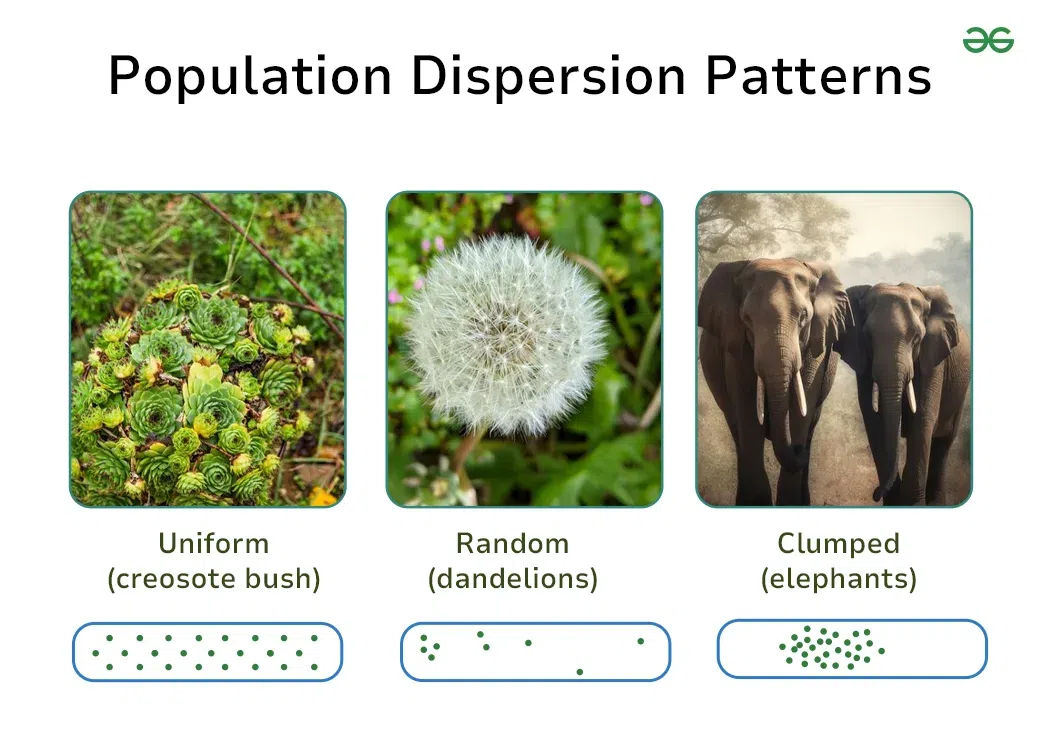Population Dispersal
Last Updated :
26 Apr, 2024
Population dispersal is the process of individuals or groups of organisms moving from one area to another. It’s a dynamic process that influences the distribution and abundance of organisms in ecosystems. Understanding population dispersal sheds light on how species colonize new habitats, interact with their environment, and respond to changes over time. Population dispersal helps in studying biodiversity, ecosystem dynamics, and the impacts of human activities on natural systems. In this article, we will study population dispersal, its types, causes and consequences in detail.

What is Population Dispersal?
Definition of Population Dispersal: Population dispersal refers to the movement of individuals from their birthplace to new areas.
Population dispersal is influenced by factors such as environmental changes, resource distribution, and competition. This phenomenon can be active, where organisms intentionally move, or passive, where external forces like wind, water, or other animals carry them. Dispersal helps in shaping the distribution and dynamics of populations, influencing gene flow, species interactions, and ecosystem functioning. Human activities such as trade and transportation can also facilitate dispersal, leading to the introduction of species to new areas. Studying patterns of biodiversity, species distributions, and ecosystem resilience help in conservation efforts and management strategies.
Also Read: Population Interactions – Modes of Interaction
Population Dispersal Types
Population dispersal includes various mechanisms through which individuals move away from their birthplace or original habitat to settle in new areas. The main types of population dispersal includes:
Active Dispersal
- Active dispersal involves intentional movement by organisms to new areas in search of better resources, suitable mates, or to escape competition or predation.
- Organisms may disperse actively by walking, flying, swimming, or other forms of locomotion.
- This type of dispersal is common among mobile organisms such as birds, mammals, and some plant seeds that can be dispersed by animals.
Passive Dispersal
- Passive dispersal occurs when organisms are carried away from their original habitat by external forces such as wind, water currents, or other animals.
- Seeds, spores, and larvae are often dispersed passively, allowing them to colonize new habitats far from their point of origin.
- Passive dispersal mechanisms are diverse and include wind dispersal (anemochory), water dispersal (hydrochory), and animal-mediated dispersal (zoochory).
Natural Dispersal
- Natural dispersal refers to movement that occurs without direct human intervention and is driven by biological and environmental factors.
- Natural dispersal mechanisms include migration of animals in response to seasonal changes, expansion of plant populations through seed dispersal, and colonization of new habitats following disturbances such as wildfires or floods.
Human-Mediated Dispersal
- Human activities such as trade, transportation, and intentional introduction of species to new areas can lead to dispersal of organisms beyond their natural ranges.
- Human-mediated dispersal can result in the spread of invasive species, introduction of pathogens to new regions, and alteration of native ecosystems.
- Examples include accidental transportation of species through cargo shipments, intentional introduction of exotic species for agriculture or ornamental purposes, and unintentional release of pets or aquarium species into the wild.
Also Read: What is Ecology? Types, Importance And Examples
Population Dispersion Pattern
Population dispersion pattern refers to the way in which individuals of a particular species are distributed across a geographical area or habitat. The most common types of population dispersion patterns are:
Clumped Dispersion
In this pattern individuals are grouped together in clusters. This is the most common pattern seen in nature. Clumped dispersion can be caused by:
- Social interactions between individuals
- Plants, animals, or individuals being unable to move around
- An uneven distribution of resources or nutrients in the area
Some examples of clumped dispersion include: elephants at a watering hole, wolves hunting in a pack, a herd of elephants, etc. Clumped dispersion can have some advantages for individual organisms, including: more access to food resources, less movement required for individuals to find mates, and improved predator protection for organisms.
Uniform Dispersion
Uniform dispersion is a pattern of distribution where individuals in a population are spaced out more or less evenly. This pattern may arise when resources are evenly distributed and individuals compete for space, leading to territoriality or spacing out to avoid competition. Some examples of uniform dispersion include:
- Plants that secrete toxins: These plants inhibit the growth of nearby individuals, a phenomenon called allelopathy.
- Territorial jaguar pairs: These animals are territorial and defend their territory from intruders.
Random Dispersion
Individuals are arranged without any particular pattern. In random dispersion, there is no predictable pattern, and organisms are equally capable of survival. Random dispersion can be caused by abiotic factors such as wind, current, or the release of reproductive material into the environment. For example, dandelion seeds are wind-dispersed, so when you blow on a dandelion, the seeds fly away somewhere. Random dispersion can have benefits such as reduced competition and a high likelihood to avoid inbreeding. However, it can also make it difficult to find mates or pollination opportunities.

Causes of Population Dispersal
Various causes of population dispersal includes:
- Resource Availability: Individuals may disperse to access resources such as food, water, shelter, or mates that are limited or unavailable in their current habitat.
- Environmental Changes: Changes in environmental conditions, such as climate change, habitat degradation, or natural disasters, can force individuals to seek more suitable habitats elsewhere.
- Competition: Competition for resources, territory, or breeding opportunities can cause individuals to disperse in search of less crowded areas with lower competition.
- Predation Pressure: High predation pressure in a particular area may make an individuals to disperse to safer locations where they face lower risks of predation.
- Mating Opportunities: Dispersal may occur in search of potential mates or to avoid inbreeding within populations, promoting gene flow and genetic diversity.
- Territorial Behavior: Territorial disputes within populations can lead individuals to disperse to avoid conflicts.
- Population Density: High population density can induce dispersal as individuals seek to reduce competition for resources or to find more suitable habitats with lower population densities.
- Natural Events: Natural events such as wildfires, floods, or volcanic eruptions can disrupt habitats, forcing individuals to disperse to safer or more suitable areas.
- Seasonal Changes: Seasonal variations in environmental conditions, such as temperature, precipitation, or food availability, can trigger seasonal migrations or dispersal to optimize survival and reproductive success.
- Anthropogenic Factors: Human activities such as urbanization, habitat fragmentation, deforestation, pollution, and land development can fragment habitats and disrupt ecosystems, leading to population dispersal.
Also Read: Population Ecology
Effects of Population Dispersal
The effects of population dispersal includes:
- Genetic Diversity: Population dispersal allow gene flow between different populations, increasing genetic diversity within and among populations.
- Species Distribution: It influences the distribution of species across landscapes, shaping their geographic ranges, which in turn affects community composition and ecosystem functioning.
- Ecosystem Dynamics: Population dispersal affects species interactions, energy flow within ecosystems, influencing processes such as predation, competition, herbivory, and mutualism.
- Adaptation and Evolution: Population dispersal allow the movement of individuals carrying advantageous traits to new habitats, promoting adaptation to local environmental conditions and causing evolutionary processes such as speciation, genetic divergence, and phenotypic plasticity.
- Population Dynamics: Population dispersal affects population size, density, and demographic rates such as birth, death, immigration, and emigration, influencing population growth, stability, and persistence over time.
- Invasion and Spread of Species: Population dispersal can allow the invasion and spread of non-native or invasive species into new areas, leading to changes in community composition, disruption of ecosystem processes, and negative impacts on native biodiversity and ecosystem services.
- Human-Wildlife Conflicts: Population dispersal can bring wildlife into closer proximity to human settlements, increasing the likelihood of conflicts such as crop damage, livestock predation, habitat destruction, and transmission of zoonotic diseases.
Also Read: Population Growth
Benefits of Population Dispersal
Population dispersal, or the migration of individuals from one group to another, can have benefits for the dispersing individual and at the population and species level.
Benefits of population dispersal includes:
- Locating new resources: Population dispersal enables individuals to find and exploit new resources, such as food, water, or shelter, in different habitats.
- Escaping unfavorable conditions: Dispersal allows individuals to move away from unfavorable environmental conditions, such as drought, extreme temperatures, or pollution, in search of more suitable habitats.
- Avoiding competing with siblings: Dispersal helps individuals avoid competition with siblings or close relatives for resources, reducing intra-specific competition within populations.
- Avoiding breeding with closely related individuals: Population dispersal reduces the likelihood of mating with closely related individuals, minimizing the risks of inbreeding and maintaining genetic diversity within populations.
- Relieving pressure for resources in an ecosystem: Dispersal spreads out the population across a larger area, reducing the pressure on resources in any single habitat or ecosystem.
- Increasing mean population size: Dispersal can lead to the colonization of new habitats, increasing the overall population size of a species across its range.
- Decreasing population variance: Population dispersal can homogenize population characteristics by distributing individuals more evenly across habitats, reducing variance within populations.
- Increasing genetic variance: Dispersal promotes gene flow between populations, increasing genetic variance and maintaining adaptive potential within and among populations.
Conclusion – Population Dispersal
Population dispersal, through active or passive means, helpsin shaping ecosystems and species dynamics. It enables the exploration of new resources, escape from unfavorable conditions, and avoidance of inbreeding, thereby enhancing genetic diversity and ecosystem resilience. Dispersal mitigates competition pressures, increases population size, and increases connectivity between habitats. Overall, it is a fundamental process causing species adaptation, evolution, and the maintenance of biodiversity in changing environments.
Also Read:
FAQs on Population Dispersal
What are the Methods of Population Dispersal?
Methods of population dispersal include active movement and passive transport by external forces like wind, water, or animals.
What Causes Population Dispersal?
Population dispersal can be caused by factors such as environmental changes, resource availability, competition, and migration patterns.
What are the 3 Types of Population?
The three types of population distributions are clustered, dispersed, and random.
What is an Example of a Dispersal?
Bird migration from breeding grounds to wintering grounds is an example of dispersal.
Why is Dispersal Important?
Dispersal is important for species survival as it allows for gene flow, colonization of new habitats, and avoidance of overcrowding and inbreeding.
What are Three Advantages of Dispersal?
Three advantages of dispersal include increased genetic diversity, colonization of new habitats, and reduced competition for resources.
How is Population Dispersed?
Population dispersal occurs through various means such as migration, birth, death, and movement influenced by factors like resource availability, competition, predation, and environmental conditions.
Share your thoughts in the comments
Please Login to comment...